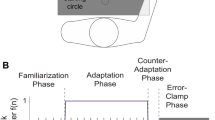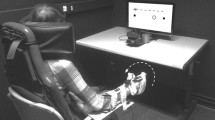Abstract
In previous studies a systematic directional error (the “motor oblique effect”) was found in 2D memory pointing movements of healthy adults. In this study we extend these observations to observe that healthy children displayed the same motor oblique effect. In contrast other spatial and temporal movement parameters (mean amplitude error, square directional and amplitude error, latency and the time to maximum velocity) changed with increasing age. Memory delay increased the square directional and amplitude error independent of age. Finally failure of movement inhibition during the delay was more frequent in children compared to adults. These results favor the hypothesis that the motor oblique effect related to perceptual processing biases is constant from childhood while other movement parameters are modulated by age reflecting the continuing optimization of motor control from childhood to adulthood. The dissociation of memory and age effects suggests that motor working memory is already mature in young children.








Similar content being viewed by others
References
Appelle S (1972) Perception and discrimination as a function of stimulus orientation: the “oblique effect” in man and animals. Psychol Bull 78:266–278
Bard C, Hay L, Fleury M (1990) Timing and accuracy of visually directed movements in children: control of direction and amplitude components. J Exp Child Psychol 50:102–118
Baud-Bovy G, Viviani P (2004) Amplitude and direction errors in kinesthetic pointing. Exp Brain Res 157:197–214
Constantinidis C, Steinmetz MA (1996) Neuronal activity in posterior parietal area 7a during the delay periods of a spatial memory task. J Neurophysiol 76(2):1352–1355
de Graaf JB, Sitting AC, Denier van der Gonn JJ (1991) Misdirections in slow goal-directed arm movements and pointer setting tasks. Exp Brain Res 84:434–438
de Graaf JB, Sitting AC, Denier van der Gonn JJ (1994) Misdirections in slow goal-directed arm movements are not primarily visually based. Exp Brain Res 99:464–472
Essock EA (1980) The oblique effect of stimulus identification considered with respect to two classes of oblique effects. Perception 9:37–46
Favilla M (2006) Reaching movements in children: accuracy and reaction time development. Exp Brain Res 169:122–125
Fischer B, Biscaldi M, Gezeck S (1997) On the development of voluntary and reflexive components in human saccade generation. Brain Res 754:285–297
Furmanski CS, Engel SA (2000) An oblique effect in human primary visual cortex. Nat Neurosci 3:535–536
Geier CF, Garver K, Terwilliger R, Luna B (2009) Development of working memory maintenance. J Neurophysiol 101:84–99
Gentaz E, Hatwell Y (1995) The haptic “oblique effect” in children’s and adults’ perception of orientation. Perception 24:631–646
Gentaz E, Hatwell Y (1998) The haptic oblique effect in the perception of rod orientation by blind adults. Percept Psychophys 60:157–160
Gentaz E, Streri A (2004) An “oblique effect” in infant’s haptic perception of spatial orientations. J Cogn Neurosci 16:253–259
Gentaz E, Baud-Bovi G, Luyat M (2008) The haptic perception of spatial orientations. Exp Brain Res 187:331–348
Gordon J, Ghilardi MF, Ghez C (1994) Accuracy of planar reaching movements. I. Independence of direction and extent variability. Exp Brain Res 99(1):97–111
Gourtzelidis P, Smyrnis N, Evdokimidis I, Balogh A (2001) Systematic errors of planar arm movements provide evidence for space categorization effects and interaction of multiple frames of reference. Exp Brain Res 139:59–69
Hay L, Bard C, Fleury M, Teasdale N (1991) Kinematics of aiming in direction and amplitude: a developmental study. Acta Psychol 77:203–215
Huttenlocher J, Hedges LV, Duncan S (1991) Categories and particulars: prototype effects in estimating spatial location. Psychol Rev 98:352–376
Irving EL, Tajik-Parvinchi DJ, Lilakas L, Gonzalez EG, Steinbach MZ (2008) Mixed pro and antisaccade performance in children and adults. Brain Res 1255:67–74
Krukowski AE, Stone LS (2005) Expansion of direction space around the cardinal axes revealed by smooth pursuit eye movements. Neuron 45:315–323
Leehey S, Moskowitz-Cook A, Brill S, Held R (1975) Orientational anisotropy in infant vision. Science 190:900–902
Luna B, Garver KE, Urban TA, Lazar NA, Sweeney JA (2004) Maturation of cognitive processes from late childhood to adulthood. Child Dev 75:1357–1372
Maffei L, Campbell FW (1970) Neurophysiological localization of the vertical and horizontal visual coordinates in man. Science 167:386–387
Mantas A, Evdokimidis I, Smyrnis N (2008) Perception action interaction: the oblique effect in the evolving trajectory of arm pointing movements. Exp Brain Res 184:605–616
Massey JT, Drake RA, Georgopoulos AP (1991) Cognitive spatial motor processes. 5. Specification of the direction of visually guided isometric forces in two-dimensional space: time course of information transmitted and effect of constant force bias. Exp Brain Res 83:446–452
McIntyre J, Stratta F, Laquaniti FC (1998) Short-term memory for reaching to visual targets: evidence for body-centered reference frames. J Neurosci 18:8423–8435
Meyer DE, Abrams RA, Kornblum S, Wright CE, Smith JE (1988) Optimality in human motor performance: ideal control of rapid aiming movements. Psychol Rev 95(3):340–370
Pelizzer G, Hauert CA (1996) Visuo-manual aiming movements in 6-to 10-year-old children: evidence for an asymmetric and asynchronous development of information processes. Brain Cogn 30:170–193
Rival C, Olivier I, Ceyte H (2003) Effects of temporal and/or spatial instructions on the speed-accuracy trade-off of pointing movements in children. Neurosci Lett 336:65–69
Schneiberg S, Sveistrup H, McFayden B, McKinley P, Levin M (2002) The development of coordination for reach-to-grasp movements in children. Exp Brain Res 146:142–154
Smyrnis N, Taira M, Ashe J, Georgopoulos AP (1991) Motor cortical activity in a memorized delay task. Exp Brain Res 92(1):139–151
Smyrnis N, Gourtzelidis P, Evdokimidis I (2000) A systematic directional error in 2-D arm movements increases with increasing delay between visual target presentation and movement execution. Exp Brain Res 131:111–120
Smyrnis N, Mantas A, Evdokimidis I (2007) “Motor oblique effect”: perceptual direction discrimination and pointing to memorized visual targets share the same preference for cardinal orientations. J Neurophysiol 97:1068–1077
Theleritis C, Smyrnis M, Mantas A, Evdokimidis I (2004) The effects of increasing memory load on the directional accuracy of pointing movements to remembered targets. Exp Brain Res 157(4):518–525
Thomas JR (1980) Acquisition of motor skills: information processing differences between children and adults. Res Q Exerc Sport 51:158–173
Yan JH, Thomas JR, Stelmach GE, Thomas KT (2000) Developmental features of rapid aiming arm movements across the life span. J Motor Beh 32(2):121–140
Yan JH, Stelmach GE, Thomas KT, Thomas JR (2003) Developmental differences in children’s ballistic aiming movements of the arm. Percept Motor Skills 47:589–598
Acknowledgment
This work was supported by internal funding from Aeginition University Hospital.
Author information
Authors and Affiliations
Corresponding author
Rights and permissions
About this article
Cite this article
Pantes, G., Mantas, A., Evdokimidis, I. et al. Memory pointing in children and adults: dissociations in the maturation of spatial and temporal movement parameters. Exp Brain Res 196, 319–328 (2009). https://doi.org/10.1007/s00221-009-1850-1
Received:
Accepted:
Published:
Issue Date:
DOI: https://doi.org/10.1007/s00221-009-1850-1




